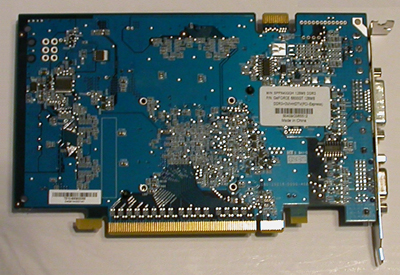Sparkle
Sparkle is using the reference NVIDIA HSF, which in this case, wins a great deal of points. The NVIDIA reference cooling solution has rubber nubs around all four corners of the HSF solution. This adds stability to the part that many other cards in this review lack. Unfortunately, the spring tension isn't wonderfully high, so cooling is a little lower than what might be desired. The spacers may add stability, but they also make it so that in order to get really good contact for cooling, the part would need to be pressed down harder than it currently is.
There were a couple of vendors who sent us "press samples" that were clocked at non-shipping clock speeds. Sparkle is included in this group, but we've asked them to only send us products that we can buy on the shelves. The part that we have in our labs boots up at 507/550, but we clocked it higher than that, easily.
You have to wonder who made the decision that seven MHz and a tiny bit of memory bandwidth was really worth sending us a press sample when we asked them not to do so. Because of that, we also can't be sure that the components that went into the part weren't binned beforehand - the 2ns DDR3 memory easily hit 610MHz.
Getting 2ns memory to clock that high is obviously not impossible. It can happen by chance (we've seen it before on earlier parts that used it), but we'd rather have no doubts.
At the same time, we asked for shipping parts and this is what we received. We'll report all the information that we have along with the numbers that we get and let the readers make the call.











84 Comments
View All Comments
Bonesdad - Wednesday, February 16, 2005 - link
Yes, I too would like to see an update here...have any of the makers attacked the HSF mounting problems?1q3er5 - Tuesday, February 15, 2005 - link
can we please get an update on this article with more cards, and replacements of defective cards?I'm interested in the gigabyte card
Yush - Tuesday, February 8, 2005 - link
Those temperature results are pretty dodge. Surely no regular computer user would have a caseless computer. Those results are only favourable and only shed light on how cool the card CAN be, and not how hot they actually are in a regular scenario. The results would've been much more useful had the temperature been measured inside a case.Andrewliu6294 - Saturday, January 29, 2005 - link
i like the albatron best. Exactly how loud is it? like how many decibels?JClimbs - Thursday, January 27, 2005 - link
Anyone have any information on the Galaxy part? I don't find it in a pricewatch or pricegrabber search at all.Abecedaria - Saturday, January 22, 2005 - link
Hey there. I noticed that Gigabyte seems to have modified their HSI cooling solution. Has anyone had any experience with this? It looks much better.Comments?
http://www.giga-byte.com/VGA/Products/Products_GV-...
abc
levicki - Sunday, January 9, 2005 - link
Derek, do you read your email at all? I got Prolink 6600 GT card and I would like to hear a suggestion on improving the cooling solution. I can confirm that retail card reaches 95 C at full load and idles at 48 C. That is really bad image for nVidia. They should be informed about vendor's doing poor job on cooling design. I mean, you would expect it to be way better because those cards ain't cheap.levicki - Sunday, January 9, 2005 - link
geogecko - Wednesday, January 5, 2005 - link
Derek. Could you speculate on what thermal compound is used to interface between the HSF and the GPU on the XFX card? I e-mailed them, and they won't tell me what it is?! It would be great if it was paste or tape. I need to be able to remove it, and then later, would like to re-install it. I might be able to overlook not having the component video pod on the XFX card, as long as I get an HDTV that supports DVI.Beatnik - Friday, December 31, 2004 - link
I thought I would add about the DUAL-DVI issue, in the new NVIDIA drivers, they show that the second DVI can be used for HDTV output. It appears that even the overscan adjustments are there.
So not having the component "pod" on the XFX card appears to be less of a concern than I thought it might be. It would be nice to hear if someone tried running 1600x1200 + 1600x1200 on the XFX, just to know if the DVI is up to snuff for dual LCD use.